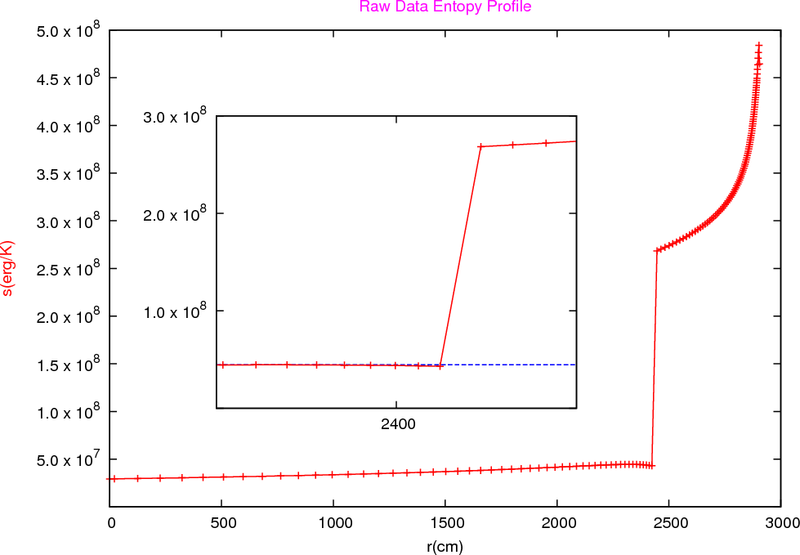XRB Paper Data/Progress
This page is set up to present some of the details of our research regarding convection on the surfaces of neutron stars under conditions amenable to Type I Xray Bursts (XRBs). We are currently in the process of comparing the convective features in both 2- and 3-dimensional models.
Intial Model Information
We start with an initial model of a pure He4 atmosphere accreted
onto the surface of a M = 1.4 M_sun, R = 10 km (g_14 = 2.45) neutron
star provided by
Entropy Profile of Raw Data - The Source of the "Overshoot"?

Newest Data
0.5cm Run with p0_update_type=2 on NYBLUE BG/L
0.5cm Run with p0_update_type=2 on NYBLUE BG/L using the Fushiki and Lamb burner
Resolved Data
0.5cm Run on Franklin from 04/02/09 - This is a properly resolved run with a wide enough domain that should not cause the weird velocity features seen in the other runs described below. Furthermore, this run uses an initial model with a entropy profile which is stable against convection (see the Initial Model Information section above). In addition, this run has been set up to use the PPM solver with the 2009 version of slope limiters.
1.25cm Run - This is a slightly under-resolved run on our local cluster, homer, that uses the new method of smoothing (see the Initial Model Information section above) but does not include a perturbed adiabatic region. Even though we have deemed this resolution to be under-resolved, the results of this run are looking qualitatively very nice aside from a weird velocity field well below the burning layer. This velociy effect is due to using too narrow of a domain.
0.5cm Run - This is a run similar to the 1.25cm run mentioned above but at higher resolution. This has been running on Franklin, but has not run to as high simulation time as the 1.25cm run on homer.
10/30/08 Franklin's Hi-res run - this shows
the data from a 0.5cm (w/4 levels of refinement) resolution run.
-
CHK FILES LOST WHEN /scratch CRASHED!
11/11/08 FLASH Hi-res run - this shows the
data from a 0.5cm resolution run using FLASH on the NERSC machine, Jacquard
started on 11/11/08. This uses Mike's unsplit solver which isn't currently AMR
friendly - therefore we are restricted to a single resolution grid and
timesteps ≤ 1 ns. -
This was taking waaay too
long and has been stopped...
Under-resolved Data
Original Comparisons - this page shows the original comparisons I sent around. The runs presented here were done using different builds of the MAESTRO code and therefore were not very good comparisons. Additionally, the pltfiles were not all generated at the same simulation time. That being said, there are a few notes worth mentioning:
- A slice through the 3d run (row 2) looks very similar to a 2d run at the same resolution (row 3).
- The amount of convective overshoot appers much smaller in the newer (rows 1-3) builds of the code than in the older build (row 4).
- The convection seems less pronounced in the regions above the helium interface in the newer builds as compared to the older build.
- A higher resolution (row 1) run seems to take longer to build up a convective region than its lower resolution counterparts (row 3, e.g.).
There are a few more things we would like to check the effect of:
- Does using a smaller buffer region below the He4 interface have an effect on the solution?
- How does using a time-centered psi term instead of the current time-lagged psi term effect the results?
- When we get AMR working, how does it compare to long duration single level runs? How does it compare to long duration multilevel runs?
- What do the results look like when base state evolution is turned off?
- What do the results look like when thermal diffusion is turned off? How physically important is thermal diffusion during an XRB?
New Comparisons - this page shows the newer comparison tests that are still in the process of being run. The runs that will be presented here are all using the code as of 09/29/08. Note this was before the lagged-psi change - I have a few runs queued up to show how this change effects results as well. In addition, for several of the runs I have comparisons of single level vs multilevel (not adaptive) as well as comparisons with evolve_base_state = T/F and use_thermal_diffusion = T/F. More to come...
Compressible with FLASH2.5 - crashes because of HSE issues at the 2.5-10cm resolution range.
Intrepid
This page will outline some details of ANL's Intrepid computing system, including locations to needed libraries or compilers as well as links to some information regarding the queuing system.